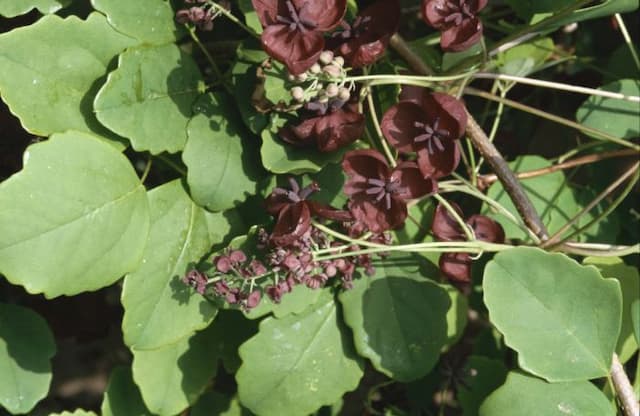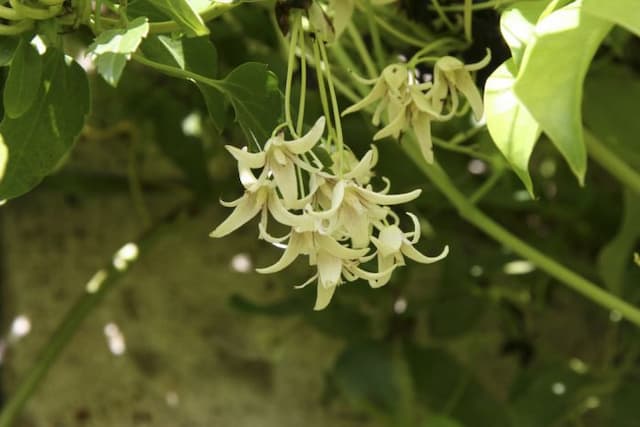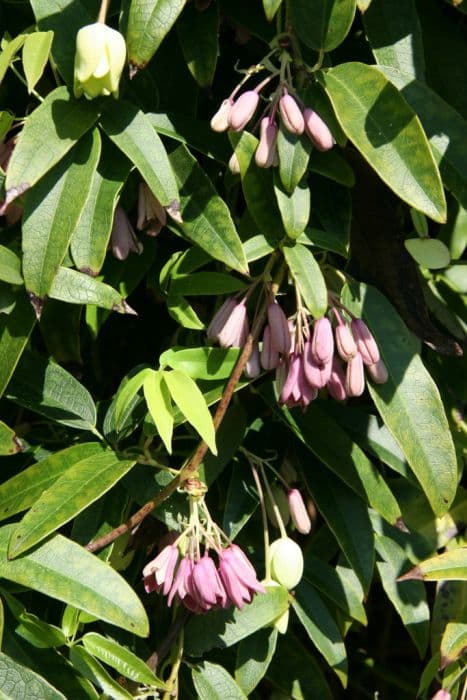White Chocolate Vine Akebia quinata 'Shirobana'

ABOUT
The Akebia quinata 'Shirobana', commonly known as white chocolate vine, features a mix of unique appearances and textures. The plant is adorned with clusters of lightly scented, white flowers which bloom in the early to mid-spring. These fragrant blossoms offer a subtle, vanilla-like fragrance and are quite attractive to pollinators. The leaves of the white chocolate vine are palmate, meaning they resemble an open hand with five fingers. These leaves are typically a rich green color that provides a lush backdrop for the flowers. The plant may also produce interesting, sausage-shaped fruits which start out purple and gradually mature to a more bluish tint. The skin of the fruit is somewhat thick and leathery, and if it cracks open, it reveals black seeds embedded in a whitish pulp. Although appealing to look at, these fruits are not commonly consumed. Overall, Shirobana presents a striking appearance with its contrast of white flowers against deep green foliage, the occasional presence of fruit adding an extra element of visual interest.
About this plant
 Names
NamesFamily
Lardizabalaceae
Synonyms
White Chocolate Vine, White-flowered Chocolate Vine
Common names
Akebia quinata 'Shirobana'.
 Toxicity
ToxicityTo humans
The Chocolate Vine, although not commonly known to be highly toxic to humans, may contain compounds that are potentially harmful if ingested in large amounts. It is not typically considered dangerous, and there is a general lack of reported cases of poisoning in humans from this plant. However, as with many ornamental plants, caution is advised since the full spectrum of its potential effects may not be well documented. In general, it is recommended to avoid consuming any part of ornamental plants due to the potential risk of gastrointestinal discomfort or more serious health issues.
To pets
Chocolate Vine is not commonly listed as a toxic plant to pets, such as dogs and cats. There is limited information available regarding its toxicity to animals, and it does not appear on major toxic plant lists maintained by organizations like the ASPCA. However, it is generally wise to prevent pets from ingesting ornamental plants since their digestive systems may react differently than humans, potentially leading to gastrointestinal upset or other health issues. If you suspect your pet has ingested a significant portion of the Chocolate Vine, it is best to consult a veterinarian.
 Characteristics
CharacteristicsLife cycle
Perennials
Foliage type
Deciduous
Color of leaves
Green
Flower color
White
Height
20-30 feet (6-9 meters)
Spread
6-9 feet (2-3 meters)
Plant type
Climber
Hardiness zones
4-8
Native area
Asia
Benefits
 General Benefits
General Benefits- Ornamental Value: Akebia quinata 'Shirobana', commonly known as white chocolate vine, has attractive foliage and distinctive white flowers that add aesthetic appeal to gardens.
- Growth Habit: Its twining vines and cascading growth habit make it an excellent choice for trellises, arbors, and fences.
- Shade Tolerance: This plant can tolerate partial shade, offering flexibility in garden design for areas that do not receive full sun.
- Drought Resistance: Once established, the white chocolate vine exhibits some drought tolerance, reducing the need for frequent watering.
- Ease of Maintenance: It requires relatively low maintenance, apart from pruning to control its growth and prevent it from becoming invasive in some regions.
- Seasonal Interest: The vine's flowers bloom in spring, providing seasonal interest and enhancing springtime garden displays.
- Wildlife Attraction: The flowers produce a subtle, sweet fragrance that can attract bees, butterflies, and other pollinators.
- Edible Fruit: Akebia quinata 'Shirobana' produces edible fruit with a sweet taste, which can be an interesting feature for culinary explorations in home gardens.
- Fast Growth: This vine is known for its rapid growth rate, allowing gardeners to quickly achieve the desired coverage or greenery.
- Versatility: It can be used in a variety of landscaping designs, from ornamental climbers to ground cover applications.
 Medical Properties
Medical PropertiesThis plant is not used for medical purposes.
 Air-purifying Qualities
Air-purifying QualitiesThis plant is not specifically known for air purifying qualities.
 Other Uses
Other Uses- Culinary Decoration: The vine-like growth of Akebia can be woven into elegant trellises to add a unique aesthetic to sophisticated dinner parties or receptions.
- Perfumery: The subtle fragrance of Akebia flowers can be captured in perfumes, offering a distinct botanical scent for fragrance blending.
- Fruit Presentation: The purple fruits of Akebia can be used in fruit platters for their exotic appearance and to add a touch of novelty to the display.
- Floral Arrangements: Fresh or dried Akebia flowers can be incorporated into floral arrangements for their delicate beauty and interesting structure.
- Craft Material: The dried vines of Akebia can be used in basket weaving or as a natural crafting material for DIY projects.
- Privacy Screens: When grown densely, Akebia vines can create a natural privacy screen for patios, balconies, or garden areas.
- Natural Dyes: The skin of the Akebia fruit may be used to derive natural dyes for textiles or crafting purposes.
- Photography Prop: The attractive foliage and unique fruit of Akebia make it an interesting subject or backdrop for botanical photography.
- Educational Tool: Akebia can be used in educational settings to teach about plant growth patterns, pollination, and fruit development.
- Theme Gardens: Akebia can be featured in Asian-themed gardens to reinforce the design aesthetic and cultural significance.
Interesting Facts
 Feng Shui
Feng ShuiThe Chocolate Vine is not used in Feng Shui practice.
 Zodiac Sign Compitability
Zodiac Sign CompitabilityThe Chocolate Vine is not used in astrology practice.
 Plant Symbolism
Plant Symbolism- Adaptability: Akebia quinata 'Shirobana,' commonly known as "White Chocolate Vine", is a vigorous climber with the ability to adapt to a variety of growing conditions, symbolizing the ability to thrive in diverse environments.
- Sensuality: With its delicate flowers and their sweet fragrance, the White Chocolate Vine can be associated with sensuality and the allure of the senses.
- Connection: As a climbing plant, it creates a network of vines that interconnect, which can be seen as a symbol of the connections among people and the strength of relationships.
- Resilience: The plant’s hardiness and persistence in growing, even in challenging settings, embody resilience and the capacity to overcome obstacles.
 Water
WaterThe Chocolate Vine requires moderate watering. Initially, after planting, water the plant deeply once a week to help establish roots. Once established, reduce watering to when the top inch of soil is dry, usually every 7 to 10 days, providing about 1 to 2 gallons of water depending on the plant’s size and the climate conditions. Avoid overwatering as Chocolate Vine doesn't like soggy soil. During the growing season, particularly in dry conditions, monitor the soil moisture levels more frequently and adjust the watering as required.
 Light
LightThe Chocolate Vine prefers full sun to part shade. Ideally, the plant should be placed in a location where it can receive at least four to six hours of sunlight daily. It can tolerate some shade, especially in the afternoon when the sunlight is most intense. A spot that receives morning sun and dappled shade in the afternoon is optimal for the best growth.
 Temperature
TemperatureThe Chocolate Vine is hardy and can withstand a range of temperatures. It thrives best in temperatures between 60 and 80 degrees Fahrenheit. The plant can survive in temperatures as low as -25 degrees Fahrenheit, making it resilient in cold climates. Nonetheless, extended exposure to temperatures below freezing may damage young shoots. Protecting the base with mulch in winter can help to shield it from extreme cold.
 Pruning
PruningPrune the Chocolate Vine to control its vigorous growth and maintain a desired shape. Pruning can be done in late winter or early spring before new growth starts. Remove any dead or tangled branches, and trim back as needed to manage size. Pruning every year or every couple of years will encourage fresh growth and keep the plant looking tidy.
 Cleaning
CleaningAs needed
 Soil
SoilThe Chocolate Vine 'Shirobana' prefers well-draining soil with compost and perlite, slightly acidic to neutral pH between 5.5 to 7.5 for optimal growth.
 Repotting
RepottingChocolate Vine 'Shirobana' should be repotted every 2-3 years, or when it becomes root-bound to encourage healthy growth.
 Humidity & Misting
Humidity & MistingChocolate Vine 'Shirobana' tolerates diverse humidity levels but thrives best at moderate humidity, around 40-60%.
 Suitable locations
Suitable locationsIndoor
Place in bright, indirect light with some direct sun.
Outdoor
Plant in dappled shade with structure to climb.
Hardiness zone
4-8 USDA
 Life cycle
Life cycleThe White Chocolate Vine, also known as Akebia quinata 'Shirobana', begins its life cycle when seeds germinate in the spring, given proper temperature and soil moisture. Seedlings emerge and establish a root system, quickly developing into vigorous vines with compound leaves. By late spring to early summer, the plant produces clusters of fragrant, white flowers that attract pollinators. Following pollination, the vine produces elongated, sausage-shaped, purple fruits by autumn, containing seeds for the next generation. Throughout the growing season, the vine spreads and climbs using twining tendrils, potentially reaching lengths of 20 to 30 feet. In winter, the vine becomes dormant, shedding leaves in colder climates, only to resume growth from its perennial woody stem as temperatures rise the following spring.
 Propogation
PropogationPropogation time
Spring to Summer
The Akebia quinata 'Shirobana', commonly known as white chocolate vine, can be propagated most popularly by softwood cuttings. This technique is typically carried out in the late spring or early summer when new growth is still soft and flexible. To do so, a gardener should select healthy, non-flowering shoots and cut sections that are about 4 to 6 inches (10 to 15 centimeters) long, ensuring each cutting has at least two sets of leaves. The lower leaves are removed, and the cut end is often dipped in a rooting hormone to enhance root development. The prepared cuttings are then placed in a well-draining potting mixture, and the environment is kept humid, often by covering the cuttings with a plastic bag or using a propagation mist system until roots have developed, which may take several weeks.




